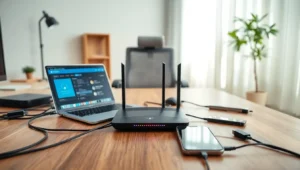Imagine a world where your pizza arrives before you’ve even finished deciding on toppings. Enter drone delivery systems, the futuristic solution that’s making this dream a reality. These flying robots are not just for capturing stunning aerial shots; they’re revolutionizing how goods get from point A to point B, all while dodging traffic and pesky parking issues.
As companies race to perfect this airborne service, the potential benefits are sky-high. Faster deliveries, reduced traffic congestion, and a sprinkle of excitement with every package dropped from the sky. Who wouldn’t want a drone swooping in with their latest online purchase? Buckle up as we explore the ins and outs of drone delivery systems and why they might just be the best thing since sliced bread—or should we say, sliced pizza?
Table of Contents
ToggleOverview of Drone Delivery Systems
Drone delivery systems are rapidly reshaping logistics and supply chains across various industries. These systems utilize unmanned aerial vehicles (UAVs) to transport goods directly to consumers, minimizing traditional delivery times. In urban areas, drones navigate traffic and deliver essentials like groceries and medical supplies.
Their technology has evolved significantly, allowing for precise navigation and drop-off capabilities. GPS and advanced imaging enable drones to avoid obstacles and ensure safe landings. Many companies leverage this innovative approach to enhance customer experiences. Notably, Amazon, UPS, and Google Wing lead the way in testing and implementing aerial delivery.
Speed defines this delivery method. Research indicates that drones can complete deliveries in astonishingly short periods, often within 30 minutes of an order. This efficiency significantly reduces the reliance on ground transportation, leading to lower emissions. Studies show drone deliveries can cut delivery times by 70%, enhancing overall operational effectiveness.
Regulatory frameworks impact the deployment of these systems. The Federal Aviation Administration (FAA) oversees airspace regulations in the United States. Compliance with safety protocols ensures drones operate without jeopardizing public safety. Companies must navigate these regulations while promoting their technological advantages.
Cost-related benefits also contribute to the attractiveness of drone dispatch services. While initial investments can be substantial, operational costs typically decrease over time as efficiencies improve. For businesses, embracing this technology can lead to increased market competitiveness.
As demand for rapid delivery continues to rise, drone delivery systems stand poised to transform the logistics landscape significantly. Their integration into existing supply chains represents a crucial step forward in meeting burgeoning consumer expectations.
Benefits of Drone Delivery Systems
Drone delivery systems offer multiple advantages that transform logistics. Key benefits include speed and efficiency alongside cost-effectiveness.
Speed and Efficiency
Speed ranks among the top characteristics of drone delivery systems. Deliveries can occur within 30 minutes of an order, often bypassing traditional ground transportation delays. Drones navigate urban environments, which reduces reliance on congested roads. This efficiency leads to timely deliveries of essential items like groceries or medical supplies. With precise navigation features, drones can avoid obstacles, ensuring safe and accurate drop-offs. Such capabilities significantly improve supply chain responsiveness to customer needs.
Cost-Effectiveness
Cost-effectiveness emerges as a crucial benefit of utilizing drones for delivery. Operational costs generally decrease over time compared to traditional delivery methods. Initial investments in drone technology can seem high, yet businesses experience savings in labor and fuel expenses. Competitive market advantages result from adopting drone systems, allowing companies to offer faster service at lower costs. As demand for rapid delivery rises, drones become essential tools in optimizing logistics strategies. Overall, cost-savings contribute to increased consumer satisfaction while enhancing the profitability of businesses.
Challenges Facing Drone Delivery Systems
Drone delivery systems encounter several obstacles that hinder their growth and widespread adoption. Regulatory and technical issues present significant challenges for companies in the industry.
Regulatory Hurdles
Regulatory frameworks dictate the safe integration of drones into national airspaces. The Federal Aviation Administration (FAA) sets stringent safety standards and operational guidelines. Obtaining permits often proves time-consuming and complex. Businesses must navigate various local, state, and federal regulations, which can vary significantly. Compliance with these rules is essential to prevent disruptions in service. Additionally, public concerns regarding safety and privacy further complicate regulatory approvals. Balancing innovation with regulation requires collaboration between companies and governing bodies.
Technical Limitations
Technical obstacles limit the efficiency of drone delivery systems. Drones face challenges with battery life, affecting their range and payload capacity. Real-time navigation and obstacle avoidance technologies must continuously evolve to ensure safe flight paths. Additionally, inclement weather conditions, such as strong winds and heavy rain, can hinder delivery capabilities. Maintenance costs can accumulate, impacting business operations. Furthermore, integrating drones with existing logistics infrastructure poses technical complications. These issues demand ongoing research and innovation to enhance the reliability of drone delivery solutions.
Future of Drone Delivery Systems
The future of drone delivery systems is shaped by continuous advancements in technology and market dynamics. Exciting innovations promise to refine efficiency and enhance user experience.
Innovations in Technology
Advancements in drone technology signal a leap forward in efficiency. Improved battery life allows drones to cover greater distances without the need for frequent recharges. Enhanced navigation systems incorporate artificial intelligence to facilitate obstacle avoidance. These innovations make deliveries more reliable and expand operational areas. Safety features also see significant enhancements, ensuring compliance with regulatory standards. Real-time data analytics can optimize delivery routes, minimizing delays. Further, communication systems enable better coordination between drones and delivery centers.
Potential Market Impact
The potential market impact of drone delivery systems could be transformative. Companies anticipate a rapid increase in consumer demand for quicker deliveries. Research estimates indicate significant growth in the logistics market as drone operations begin to scale. Traditional delivery services may face heightened competition, compelling them to adopt these technologies. Cost savings also present a compelling business case, with reduced labor and fuel expenses contributing to improved profit margins. Furthermore, the expansion of drone delivery services can create new job opportunities in tech and operations. As consumer preferences shift toward immediate gratification, the influence of drone delivery systems on the marketplace becomes increasingly profound.
Drone delivery systems are set to revolutionize the logistics landscape by providing faster and more efficient ways to transport goods. As technology continues to advance, the potential for rapid deliveries will only increase, meeting the growing consumer demand for immediacy.
While challenges like regulatory hurdles and technical limitations remain, ongoing innovation and collaboration between companies and governing bodies will pave the way for broader adoption. The future of drone delivery holds promise not just for businesses looking to enhance their operations but also for consumers eager for swift service.
As these systems evolve, they’ll likely reshape how goods are delivered, offering a glimpse into a more efficient and responsive marketplace.





